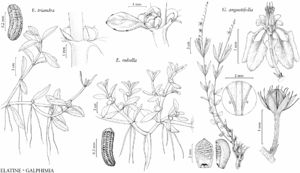Galphimia
Icon. 5: 61, plate 489. 1799.
| Taxon | Illustrator ⠉ | |
|---|---|---|
 | Galphimia angustifolia Elatine rubella Elatine triandra | Karin Douthit Barbara Alongi Barbara Alongi |
Subshrubs or shrubs [occasionally small trees]. Leaves usually bearing glands proximally on blade margin [and/or on petiole]; stipules intrapetiolar, distinct. Inflorescences terminal, racemes [several grouped in panicle]. Pedicels sessile or raised on peduncles. Flowers all chasmogamous, 6+ mm diam., showy with visible petals, stamens, and styles; calyx glands 0 [1 very small gland at base of sinus between some or all adjacent sepals]; corollas nearly radial [moderately bilaterally symmetric], petals lemon yellow, becoming orange or red in age [suffused with red], glabrous [rarely hairy]; stamens 10, all fertile; anthers subequal; pistil 3-carpellate, carpels connate in ovary along broad adaxial faces; styles 3, subulate, slender; stigmas terminal, minute. Fruits schizocarps, breaking apart at maturity into 3 cocci; cocci unwinged, bearing narrow dorsal keel, walls thin, brittle. x = 6.
Distribution
Tex., Mexico, Central America, South America
Discussion
Species 26 (1 in the flora).
Galphimia is most diverse from Texas south to Nicaragua with 22 species in that region; only four species are known from South America south of the Amazon valley. Galphimia gracilis Bartling, native to eastern Mexico, is widely cultivated in the tropics and subtropics as an ornamental shrub.